by Jonathan Atteberry and Patrick J. Kiger
There may be no greater tribute to a society’s ingenuity and vision than Egypt’s Great Pyramid of Giza. Originally standing 481 feet (147 meters) tall, the Great Pyramid towers over monuments like the Statue of Liberty and Big Ben [source: PBS]. Of course, the pyramids are only part of ancient Egypt’s legacy.
Over the thousands of years ancient Egyptians thrived, they ushered in perhaps the most advanced civilization the world had ever known, and many of the fixtures of their society are still commonplace. For instance, Egyptian women donned ornate jewelry and wigs, the men boxed, fenced and wrestled for sport and the children played with board games, dolls and other toys. They also thrived as inventors, and, as you’ll see in this list of five amazing Egyptian inventions, their creations changed everything from fashion to agriculture so drastically that we still see their influence today.
- Eye Make-up
Sure, eye makeup might not rank alongside fire or the wheel as one of the most important discoveries in human history, but it gives the Egyptians a run for longevity. Since they first invented eye makeup as far back as 4000 B.C., it’s never gone out of style. Even more ssive, some cosmetically-minded cultures still create makeup using the same techniques pione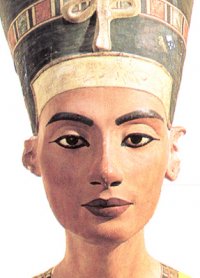 ered by the Egyptians thousands of years ago. They combined soot with a mineral called galena to create a black ointment known as kohl, which is still popular today. They could also create green eye makeup by combining a mineral called malachite with galena to tint the ointment.
ered by the Egyptians thousands of years ago. They combined soot with a mineral called galena to create a black ointment known as kohl, which is still popular today. They could also create green eye makeup by combining a mineral called malachite with galena to tint the ointment.
For the Egyptians, makeup was not limited to women. Status and appearance went hand in hand, and as far as the upper class was concerned, the more makeup the better. Fashion was only part of the reason for the Egyptians’ notoriously heavy hand when applying eyeliner. They also believed that applying a thick coating of the stuff could cure various eye diseases and even keep them from falling victim to the evil eye.
2. Written Language/Egyptian hieroglyphs
The use of drawings to tell stories is certainly nothing new; cave paintings found in France and Spain date all the way back to 30000 B.C. [source: Wherely]. But drawings and paintings wouldn’t evolve into the first written language for thousands of years, when the first writing systems arose out of Egypt and Mesopotamia.
The Egyptian writing system began with pictograms, the first of which date back to 6000 B.C. [source: Harrow]. Pictograms were simple depictions of the words they represented, but they had limitations. Over time, Egyptians added other elements to their writing system, including alphabetlike characters that stood for certain sounds and other characters, allowing them to write out names and abstract ideas.impre Today, everyone knows the Egyptians for the creation of hieroglyphics, which contained a mixture of alphabetic, syllabic symbols, as well as ideograms — pictures that stood for whole words — found extensively within Egyptian tombs and other places. The writing tells tales of war, politics and culture that give us a great understanding of ancient Egyptian society. Of course, we have the Rosetta stone to thank for our ability to interpret the writing. Its discovery, along with the work of French scholar Jean-Francois Champollion to decode the stone, marked the end of a 1,500-year-period during which Egyptian writing was shrouded in mystery [source: Discovering Egypt].
Today, everyone knows the Egyptians for the creation of hieroglyphics, which contained a mixture of alphabetic, syllabic symbols, as well as ideograms — pictures that stood for whole words — found extensively within Egyptian tombs and other places. The writing tells tales of war, politics and culture that give us a great understanding of ancient Egyptian society. Of course, we have the Rosetta stone to thank for our ability to interpret the writing. Its discovery, along with the work of French scholar Jean-Francois Champollion to decode the stone, marked the end of a 1,500-year-period during which Egyptian writing was shrouded in mystery [source: Discovering Egypt].
3. Egyptian papyrus paper
No one will deny that the Chinese changed the world forever with the invention of paper around 140 B.C., but what many people don’t know is that the Egyptians had developed an admirable substitute thousands of years earlier from the papyrus plant [source: UCLA]. This stiff, reedlike plant grew (and continues to grow) in the marshy areas lining the Nile, among other places. Its tough, fibrous interior proved ideal for making durable sheets of writing material, along with sails, sandals, mats and other necessities of ancient Egyptian life. After the sheets were made, they were often combined into scrolls, which were then filled everything from religious texts to literature and even music.
everything from religious texts to literature and even music.
Ancient Egyptians kept the time-consuming process of manufacturing papyrus a closely guarded secret, allowing them to trade papyrus sheets throughout the region. Because the process was never documented, it was ultimately lost until Dr. Hassan Ragab found a way to make papyrus sheets in 1965 [source: Egyptian Papyrus].
4. Calendar
Many of us would be lost without a calendar to help us remember dental appointments and important meetings, but in ancient Egypt, a calendar could mean the difference between feast and famine. Without a calendar, ancient Egyptians had no way of knowing when the annual flooding of the Nile would begin. Without that knowledge, their entire agricultural system would be put at risk, so a few thousand years before the common era, they started using one.
Their civil calendar was so closely tied into farming that the Egyptians divided it up into three main seasons: inundation, growing and harvest. Each season had four months, with each month divided into 30 days. Adding it all up, you get 360 days a year — a bit short of an actual year. To make up the difference, the Egyptians added five days between the harvest and inundation seasons. These five epagomenal days, were designated as religious holidays set aside to honor the children of the gods [source: Weininger].
5.Egyptian PlowThe plow certainly made the process of planting crops much easier, but farming was still backbreaking work. Farmers used short-handled hoes to till the ground, forcing them to stoop over in the hot sun all day long. The Egyptians also carried seeds in baskets and used scythes to help them harvest their crops. Perhaps the most ingenious farming tools, however, were the pigs and sheep they used to trample seed into the dirt. 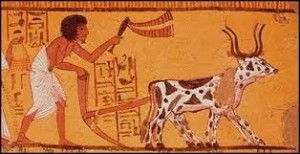
While historians aren’t entirely certain of where the plow originated, evidence suggests that the Egyptians and Sumerians were among the first societies to employ its use around 4000 B.C. [source: Pryor]. Those plows certainly had room for improvement. Likely built from modified hand tools, the plows were so light and ineffective that they are now referred to as “scratch plows” for their inability to dig deep into the ground. What’s more, the plows ran on nothing more than elbow grease. For instance, wall paintings illustrate four menpulling a plow through a field together — not a great way to spend a day in the scorching Egyptian sun.
That all changed in 2000 B.C., when the Egyptians first hooked their plows to oxen [source: Leju]. Early designs were connected to the horns of cattle but proved to interfere with the animal’s ability to breathe. Later versions incorporated a system of straps and were much more effective. The plow revolutionized farming in ancient Egypt and, combined with the steady rhythm of the Nile River, made farming easier for the Egyptians than perhaps any other society of the time.
6. Breath Mints
The next time you peruse the counter at the 7-Eleven for Mentos or Breath Savers, you should thank the ancient Egyptians for devising a way to conceal the unpleasant aromas our mouths sometimes exude. Just as in modern times, bad breath in ancient Egypt often was a symptom of poor dental health. Unlike us, the Egyptians didn’t gorge on sugary soft drinks and foods that contribute to tooth decay, but the stones they used to grind flour for bread contributed a lot of sand and grit to their diet, which wore down tooth enamel to expose the pulp of the tooth, making it vulnerable to infection. The Egyptians had specialists for many medical problems, but unfortunately, they didn’t have dentists or oral surgeons to fix their deteriorating teeth and gums. Instead, they simply suffered, and scientists who’ve examined mummies have found severely worn teeth and evidence of abscesses, even in youthful Egyptians. To cope with the unpleasant odors from their rotting mouths, Egyptians invented the first mints, which were a combination of frankincense, myrrh and cinnamon boiled with honey and shaped into pellets [source: Brier and Hobbs].
The Egyptians had specialists for many medical problems, but unfortunately, they didn’t have dentists or oral surgeons to fix their deteriorating teeth and gums. Instead, they simply suffered, and scientists who’ve examined mummies have found severely worn teeth and evidence of abscesses, even in youthful Egyptians. To cope with the unpleasant odors from their rotting mouths, Egyptians invented the first mints, which were a combination of frankincense, myrrh and cinnamon boiled with honey and shaped into pellets [source: Brier and Hobbs].
7. Bowling
Writers of the 1998 comedy film “The Big Lebowski,” in which pivotal scenes take place in a bowling alley, might have had to find a different motif if it hadn’t been for the ancient Egyptians. In Narmoutheos, a settlement 56 miles (90 kilometers) south of Cairo that dates back to the Roman occupation period in the second and third centuries A.D., archaeologists have discovered a room containing a set of lanes and a collection of balls of various sizes. Measuring about 13 feet (3.9 meters) long, the 7.9-inch-wide (20-centimeter), 3.8-inch-deep (9.6-centimeter) lane featured a 4.7-inch (11.9-centimeter) square opening at its center.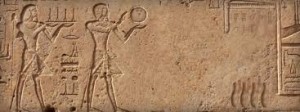
Unlike modern bowling, in which bowlers strive to knock down pins at the end of the alley, Egyptian bowlers aimed for the hole in the middle. Competitors stood at opposite ends of the lane and attempted to roll balls of different sizes into the center hole and in the process also knock their opponent’s ball off course [source: Lorenzi].
Perhaps the Egyptians were the first ancient people to fuss over their hair, or perhaps not. But either way, they considered hair unhygienic, and the sweltering heat of their homeland made long tresses and beards uncomfortable. Thus, they cut their hair short or shaved their heads and faces regularly. Priests, who apparently were especially averse to hirsuteness, shaved their entire bodies every three days [source: Knight]. For much of their history, being clean-shaven was considered fashionable, and being stubbly came to be considered a mark of poor social status. To that end, the Egyptians invented what may have been the first shaving implements, a set of sharp stone blades set in wooden handles, and later replaced those with copper-bladed razors. They also invented the barbering profession. The first barbers made house calls to wealthy aristocrats’ houses but tended to ordinary customers outdoors, seating them on benches underneath shady sycamore trees.
To that end, the Egyptians invented what may have been the first shaving implements, a set of sharp stone blades set in wooden handles, and later replaced those with copper-bladed razors. They also invented the barbering profession. The first barbers made house calls to wealthy aristocrats’ houses but tended to ordinary customers outdoors, seating them on benches underneath shady sycamore trees.
Oddly, though, they also retained a fascination for facial hair, or at least the appearance of having some. The Egyptians took shorn hair and sheep’s wool and fashioned them into wigs and fake beards — which, even more oddly, were sometimes worn by Egyptian queens as well as kings [source: Dunn]. The fake beards had various shapes, to indicate the dignity and social position of their wearer. Ordinary citizens wore small fake beards about 2 inches (5 centimeters) long, while kings wore their phony whiskers to extravagant lengths and had them trimmed to be square at the end. Egyptian gods had even more luxurious long beards, which were turned up at the tip [source: King].
 Whenever you lock your door at night and slide the deadbolt into place, say a prayer of thanks for the ancient Egyptian invention of door locks. The earliest such device, created around 4000 B.C., basically was a pin-tumbler lock, in which a hollowed-out bolt in the door was connected to pins that could be manipulated by insertion of a key. When the key pushed upward on the pins, they slipped away from the bolt shaft, allowing it to be withdrawn.
Whenever you lock your door at night and slide the deadbolt into place, say a prayer of thanks for the ancient Egyptian invention of door locks. The earliest such device, created around 4000 B.C., basically was a pin-tumbler lock, in which a hollowed-out bolt in the door was connected to pins that could be manipulated by insertion of a key. When the key pushed upward on the pins, they slipped away from the bolt shaft, allowing it to be withdrawn.
One drawback of these ancient locks was their size. The biggest ones were up to 2 feet (0.6 meters) in length [source: How It Works]. Egyptian locks actually were more secure than the technology later developed by the Romans, who used a simpler design with a spring rather than a bolt to hold the door in place. The Roman locks were hidden inside the door, but compared to the Egyptian locks, they were relatively easy to pick [source: de Vries].
The discovery of the Egyptian toothpaste concoction was presented in 2003 at a dental conference in Vienna, where some of the dentists sampled a replication of the ancient blend. “I found that it was not unpleasant,” one dentist told the Telegraph. “It was painful on my gums and made them bleed as well, but that’s not a bad thing, and afterwards my mouth felt fresh and clean” [source: Zoech].
As we mentioned previously, the Egyptians had a lot of trouble with their teeth, in large part because their bread had grit and sand in it, which wore out their enamel. While they didn’t have dentistry, they did make some effort to keep their teeth clean. Archaeologists have found toothpicks buried alongside mummies, apparently placed there so that they could clean food debris from between their teeth in the afterlife. Along with the Babylonians, they’re also credited with inventing the first toothbrushes, which were frayed ends of wooden twigs.
But the Egyptians also contributed a innovation to dental hygiene, in the form of toothpaste. Early ingredients included the powder of ox hooves, ashes, burnt eggshells and pumice, which probably made for a less-than-refreshing morning tooth-care ritual [source: Colgate.com]. Archaeologists recently found what appears to be a more advanced toothpaste recipe and how-to-brush guide written on papyrus that dates back to the Roman occupation in the fourth century A.D. The unknown author explains how to mix precise amounts of rock salt, mint, dried iris flower and grains of pepper, to form a “powder for white and perfect teeth” [source: Zoech]
article found @http://science.howstuffworks.com/innovation/inventions/5-amazing-ancient-egyptian-inventions.htm##page=9


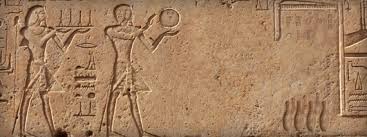
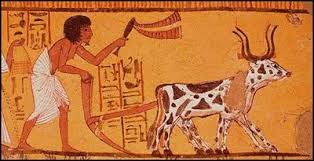





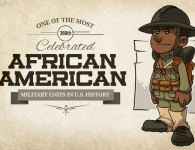


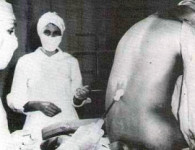


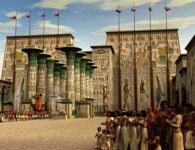



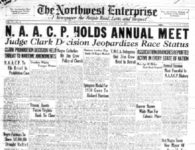
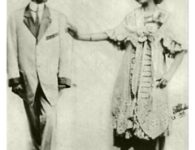


20 Comments
I do not even know how I ended up here, but I thought this post was good.
I do not know who you are but certainly you’re going to a famous blogger if you are not already ;
) Cheers!
I was able to find good information from your articles.
5/10/2019 I’m pleased by the manner in which blackthen.com deals with this type of issue! Generally on point, often polemic, consistently well-researched and more often than not quite thought-provoking.
5/11/2019 In my opinion, blackthen.com does a excellent job of handling issues of this kind. Even if often deliberately polemic, the material posted is generally well-written and stimulating.
It’s very effortless to find out any matter on web as compared to textbooks, as I found this post at this
web page.
5/13/2019 @ 11:30:11 In my estimation, blackthen.com does a excellent job of handling subjects of this sort. While often intentionally controversial, the material posted is in the main well-written and challenging.
Hi to every one, the contents present at this site are really awesome for people experience, well,
keep up the good work fellows.
Your way of telling everything in this post is genuinely good, all can without
difficulty know it, Thanks a lot.
Hello there! Do you know if they make any plugins
to safeguard against hackers? I’m kinda paranoid about losing everything I’ve worked hard on. Any suggestions?
Very great post. I simply stumbled upon your
weblog and wanted to say that I’ve truly enjoyed browsing your weblog posts.
After all I will be subscribing for your rss feed and I hope you write once more soon!
Wonderful items from you, man. I’ve take into account your stuff previous to and you are just too fantastic.
I really like what you have obtained right here, really like what you’re saying and the way in which by which you assert it.
You’re making it entertaining and you continue to take care of to keep it smart.
I can not wait to read much more from you.
This is really a great website.
I was recommended this website by way of my cousin. I am now not
positive whether or not this publish is written through him as no one else
understand such certain approximately my difficulty.
You’re incredible! Thanks!
I simply couldn’t depart your site before suggesting
that I really loved the usual info an individual supply on your guests?
Is gonna be back ceaselessly in order to inspect
new posts
Your way of explaining the whole thing in this piece
of writing is in fact good, every one be able to without difficulty
know it, Thanks a lot.
5/30/2019 In my view, blackthen.com does a good job of handling subjects of this kind! Even if ofttimes intentionally controversial, the posts are in the main thoughtful and stimulating.
If you are going for best contents like myself, simply go to see this site
every day since it gives quality contents, thanks
Woah! I’m really digging the template/theme of this website.
It’s simple, yet effective. A lot of times it’s hard to get that “perfect balance” between superb
usability and visual appearance. I must say you’ve done
a superb job with this. Also, the blog loads very fast for me on Safari.
Exceptional Blog!
This is very interesting, You’re a very skilled blogger.
I have joined your feed and look forward to seeking more of your excellent post.
Also, I have shared your web site in my social networks!
Pretty! This was an incredibly wonderful post. Thanks for supplying this information.
Love what you are doing! Keep it up.